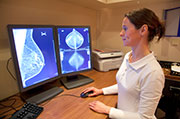- Navigating Your Midlife Crisis: Embracing New Possibilities
- City Raccoons Showing Signs of Domestication
- Mapping the Exposome: Science Broadens Focus to Environmental Disease Triggers
- One Week Less on Social Media Linked to Better Mental Health
- Your Brain Changes in Stages as You Age, Study Finds
- Some Suicide Victims Show No Typical Warning Signs, Study Finds
- ByHeart Formula Faces Lawsuits After Babies Sickened With Botulism
- Switch to Vegan Diet Could Cut Your Greenhouse Gas Emissions in Half
- Regular Bedtime Does Wonders for Blood Pressure
- Dining Alone Could Mean Worse Nutrition for Seniors
Mammography Cuts Breast Cancer Deaths by 28 Percent: Study


Mammography screening of healthy women reduces deaths from breast cancer by about 28 percent, according to a new study.
This latest research, published online in the June 18 issue of BMJ, is likely to reignite the debate over the timing of breast cancer screening for women at average risk of the disease.
“Mammography screening saves lives — most likely due to earlier diagnosis of breast cancer — and therefore better effect of treatment,” said study researcher Dr. Lars Vatten, a professor of epidemiology at the Norwegian University of Science and Technology in Trondheim.
Although Vatten calls the benefits of X-ray screening substantial, two U.S. experts say they’re “modest at best.”
“While the benefits are small, the harms of screening are real and include overdiagnosis, psychological stress, and exorbitant health care costs,” Dr. Joann Elmore of the University of Washington School of Medicine in Seattle and Dr. Russell Harris of the University of North Carolina, Chapel Hill, wrote in an editorial accompanying the study.
Doctors should provide women with balanced information about the pros and cons of routine mammograms so that they can make informed decisions, the editorialists said.
But Vatten believes the risks are small compared to the upside of screening. “The reduction in mortality is large enough to outweigh the harms related to mammography screening,” he said.
Experts are divided about the ideal age for women to begin having the exam and how often. In 2009, the U.S. Preventive Services Task Force, an independent panel of experts, recommended that women ages 50 to 74 get a mammogram every two years. It said women between 40 and 49 should talk to their doctor about whether to have the exam every two years. The task force had no recommendation for women 75 and older.
However, the American Cancer Society and other medical organizations continue to recommend women at average risk start annual mammograms at age 40.
In the new study, Vatten and his colleagues evaluated the effectiveness of mammograms by comparing death rates from breast cancer among Norwegian women between 1986 and 2009. They looked at data on women ages 50 to 69 who were invited to get a mammogram every two years and those who were not yet invited because the national program was being phased in.
They evaluated more than 15 million person-years of observation, finding breast cancer deaths occurred in 1,175 of the women invited for a mammogram, and nearly 9,000 of those who weren’t invited for screening. “Person-years” is a method used by researchers to take into account the number of people in a study and the amount of time each was in it.
The 28 percent reduction in breast cancer deaths they found means that for every 10,000 women invited to get a mammogram, about 27 deaths from breast cancer could be avoided.
The researchers then estimated the effect of the invitation to get a mammogram among women who actually got one, figuring that about three-quarters followed through. They estimated a 37 percent reduction in breast cancer deaths among women who actually got the exam.
Besides evaluating the effect of the mammograms on breast cancer deaths, “a second aim was to find out how many women need to be invited to mammography screening to prevent one breast cancer death,” Vatten said. “And we found that 368 women need to be invited to prevent one death.”
Furthermore, 280 women would need to be screened to prevent one breast cancer death, they estimated.
The benefits found in the Norwegian study reflect the findings of other studies, said Robert Smith, director of cancer screening for the American Cancer Society.
Smith, who wasn’t involved in the study, said he, too, would describe the benefits found as substantial.
“This provides strong support for the value of a screening program for breast cancer,” Smith said. However, the study wasn’t designed to assess when mammograms should begin or how often they should be repeated.
More information
For more on mammograms, visit the U.S. National Cancer Institute.
Source: HealthDay
Copyright © 2025 HealthDay. All rights reserved.










